Morphological Optimization of Low-Density Commercial Streets: A Multi-Objective Study Based on Genetic Algorithm
Abstract
1. Introduction
2. Methods
2.1. Research Framework
2.2. Study Area
Residential Block Prototypes
2.3. Urban Morphological Indicators
2.4. Generation of Land Parcel Model
3. Simulation Process and Optimization Algorithm
3.1. Simulation Tools and Data Processing Tools
3.2. Building Performance Simulation Based on Grasshopper
3.3. Multi–Objective Optimization
4. Results and Discussion
4.1. Results of Multi-Objective Optimization
4.1.1. Spatial Distribution of Multi-Objective Optimization Results
4.1.2. Comparative Analysis of Dominated Solutions and Non-Dominated Solutions
4.1.3. Analysis of Block Performance Improvement
4.2. Trend Analysis of Pareto-Optimal Solutions in the Optimization Process
4.3. Analysis of the Influence Degree of Design Variables
4.4. Correlative Analysis of Urban Morphological Parameters and Objective Variables
4.5. Limitations and Future Work
5. Conclusions
- (1)
- Multi-objective optimization model implemented via Wallacei exhibits strong performance, with Pareto-optimal solutions evenly scattered at the leading edge of feasible solutions. Compared with dominated solutions, the three objectives performance within Pareto-optimal solutions has been improved. The optimization trends are as follows: E–1 and E–2 (enclosed buildings) always appear in the optimal solutions, while H–1 (Hybrid buildings) rarely appear. The block shifts from high BEC and high FAR in the early stage, to low BEC and low FAR in the middle stage, and then to high BEC and high FAR in the later stage. In the middle stage, 1–3 story point buildings appear more frequently, while in the later stage, 4–6 story point buildings appear more frequently. Enclosed buildings are mainly south-facing, followed by east and west orientations. The optimal solution closest to the ideal solution consists of slab buildings and enclosed buildings, with no point or hybrid buildings. The occurrence frequency of enclosed buildings is relatively low in the central plots (i.e., Plot 2 and Plot 4), while that of slab-type buildings is relatively high in these plots. Therefore, priority should be given to the combination of enclosed and slab-type buildings, while excessive use of hybrid and point-type buildings should be curbed. The shading properties of enclosed buildings can be utilized to improve thermal comfort in summer.
- (2)
- The multi-objective optimization model is capable of effectively optimizing the three objectives related to block buildings. Compared with the extremely inferior solution, the optimal solution closest to the ideal point reduces BEC by 33.2% and UTCI by 1.3%, and increases FAR by 102.8%. This suggests that the optimization algorithm is capable of effectively accomplishing multi-objective optimization of BEC, UTCI and FAR of block buildings, thereby providing a reusable technical paradigm for the optimization of urban morphology at the meso-scale.
- (3)
- The findings from the sensitivity analysis suggest that design variables exert varying degrees of influence on the three optimization objectives. Among them, the number of floors of the three slab-type buildings (S–1, S–2 and S–4) has the most significant impacts on BEC, UTCI and FAR: their impacts on BEC are 87.5%, 60.8% and 55% respectively; on UTCI are 48.1%, 51% and 45.4%, respectively; and on FAR are 85.8%, 58.5% and 51.6%, respectively. In contrast, the opening angle of enclosed buildings has a certain impact on UTCI, but has minimal influence on BEC and no impact on FAR.
- (4)
- The results of the correlation analysis indicate that the urban morphological parameter-energy consumption-related indicators have significant correlations with BEC, UTCI and FAR. These indicators reflect the building density of the block, the degree of shading, solar radiation in the block, etc. SVF, OSR and SF are obviously negatively correlated with BEC, while BD, AF and EUI are positively correlated with BEC. In terms of outdoor thermal comfort, SVF, OSR and SF are positively correlated with UTCI: a more open outdoor sky enhances solar radiation, which increases UTCI and reduces outdoor comfort. AF and EUI are negatively correlated with UTCI; as buildings become taller, the shaded area increases, leading to a decrease in UTCI. Among these indicators, OSR and AF have the greatest impact on FAR.
Author Contributions
Funding
Data Availability Statement
Conflicts of Interest
References
- UN-Habitat. Unlocking the Potential of Cities: Financing Sustainable Urban Development. UN-Habitat Rep. 2023, 1–68. [Google Scholar]
- Wu, C.; Pan, H.; Luo, Z.; Liu, C.; Huang, H. Multi-Objective Optimization of Residential Building Energy Consumption, Daylighting, and Thermal Comfort Based on BO-XGBoost-NSGA-II. Build. Environ. 2024, 254, 111386. [Google Scholar] [CrossRef]
- Liu, Q.; Ren, J. Research on the Building Energy Efficiency Design Strategy of Chinese Universities Based on Green Performance Analysis. Energy Build. 2020, 224, 110242. [Google Scholar] [CrossRef]
- Liu, J.; Li, Z.; Zhong, Q.; Wu, J.; Xie, L. Multi-Objective Optimization of Daylighting Performance and Energy Consumption of Educational Buildings in Different Climatic Zones of China. J. Build. Eng. 2024, 95, 110322. [Google Scholar] [CrossRef]
- China Association of Building Energy Efficiency. Research Report on Building Energy Consumption in China (2023); China Association of Building Energy Efficiency: Beijing, China, 2023. [Google Scholar]
- Xia, B.; Li, Z. Optimized Methods for Morphological Design of Mesoscale Cities Based on Performance Analysis: Taking the Residential Urban Blocks as Examples. Sustain. Cities Soc. 2021, 64, 102489. [Google Scholar] [CrossRef]
- Khraiwesh, M.M.; Genovese, P.V. Outdoor Thermal Comfort Integrated with Energy Consumption for Urban Block Design Optimization: A Study of the Hot-Summer Mediterranean City of Irbid, Jordan. Sustainability 2023, 15, 8412. [Google Scholar] [CrossRef]
- Chokhachian, A.; Perini, K.; Giulini, S.; Auer, T. Urban Performance and Density: Generative Study on Interdependencies of Urban Form and Environmental Measures. Sustain. Cities Soc. 2020, 53, 101952. [Google Scholar] [CrossRef]
- Yu, W.; Li, B.; Jia, H.; Zhang, M.; Wang, D. Application of Multi-Objective Genetic Algorithm to Optimize Energy Efficiency and Thermal Comfort in Building Design. Energy Build. 2015, 88, 135–143. [Google Scholar] [CrossRef]
- La Gennusa, M.; Costanzo, S.; Peri, G.; Rizzo, G.; Rieradevall, J. Reducing Electric and Thermal Energy Needs in Buildings by Using Innovative Envelope Materials Laboratory Results of Bio-Composites Embodying Tomato Plant Stems. In Proceedings of the 2018 IEEE International Conference on Environment and Electrical Engineering and 2018 IEEE Industrial and Commercial Power Systems Europe (EEEIC/I&CPS Europe), Palermo, Italy, 6 December 2018; pp. 1–5. [Google Scholar]
- Wu, W.; Guo, J.; Li, J.; Hou, H.; Meng, Q.; Wang, W. A Multi-Objective Optimization Design Method in Zero Energy Building Study: A Case Study Concerning Small Mass Buildings in Cold District of China. Energy Build. 2018, 158, 1613–1624. [Google Scholar] [CrossRef]
- Nasrollahzadeh, N. Comprehensive Building Envelope Optimization: Improving Energy, Daylight, and Thermal Comfort Performance of the Dwelling Unit. J. Build. Eng. 2021, 44, 103418. [Google Scholar] [CrossRef]
- Luo, Z.; Lu, Y.; Cang, Y.; Yang, L. Study on Dual-Objective Optimization Method of Life Cycle Energy Consumption and Economy of Office Building Based on HypE Genetic Algorithm. Energy Build. 2022, 256, 111749. [Google Scholar] [CrossRef]
- Yang, Z.; Ghahramani, A.; Becerik-Gerber, B. Building Occupancy Diversity and HVAC (Heating, Ventilation, and Air Conditioning) System Energy Efficiency. Energy 2016, 109, 641–649. [Google Scholar] [CrossRef]
- Wang, R.; Lu, S.; Feng, W. A Three-Stage Optimization Methodology for Envelope Design of Passive House Considering Energy Demand, Thermal Comfort and Cost. Energy 2020, 192, 116723. [Google Scholar] [CrossRef]
- Xu, Y.; Zhang, G.; Yan, C.; Wang, G.; Jiang, Y.; Zhao, K. A Two-Stage Multi-Objective Optimization Method for Envelope and Energy Generation Systems of Primary and Secondary School Teaching Buildings in China. Build. Environ. 2021, 204, 108142. [Google Scholar] [CrossRef]
- Zhao, Y.; Ding, X.; Wu, Z.; Yin, S.; Fan, Y.; Ge, J. Impact of Urban Form on Building Energy Consumption in Different Climate Zones of China. Energy Build. 2024, 320, 114579. [Google Scholar] [CrossRef]
- Zhu, S.; Ma, C.; Wu, Z.; Huang, Y.; Liu, X. Exploring the Impact of Urban Morphology on Building Energy Consumption and Outdoor Comfort: A Comparative Study in Hot-Humid Climates. Buildings 2024, 14, 1381. [Google Scholar] [CrossRef]
- Huang, W.; Tian, F.; Huang, T. Energy Performance-Oriented Multi-Objective Optimization of Spatial Form of High-Rise Residential Blocks in the Changsha Region. Buildings 2024, 15, 56. [Google Scholar] [CrossRef]
- Xu, S.; Wang, S.; Li, G.; Zhou, H.; Meng, C.; Qin, Y.; He, B.J. Performance-Based Design of Residential Blocks for the Co-Benefits of Building Energy Efficiency and Outdoor Thermal Comfort Improvement. Build. Environ. 2024, 264, 111926. [Google Scholar] [CrossRef]
- Liu, K.; Xu, X.; Zhang, R.; Kong, L.; Wang, W.; Deng, W. Impact of Urban Form on Building Energy Consumption and Solar Energy Potential: A Case Study of Residential Blocks in Jianhu, China. Energy Build. 2023, 280, 112727. [Google Scholar] [CrossRef]
- Xu, S.; Sang, M.; Xie, M.; Xiong, F.; Mendis, T.; Xiang, X. Influence of Urban Morphological Factors on Building Energy Consumption Combined with Photovoltaic Potential: A Case Study of Residential Blocks in Central China. Build. Simul. 2023, 16, 1777–1792. [Google Scholar] [CrossRef]
- Taleghani, M.; Tenpierik, M.; Van Den Dobbelsteen, A.; De Dear, R. Energy Use Impact of and Thermal Comfort in Different Urban Block Types in the Netherlands. Energy Build. 2013, 67, 166–175. [Google Scholar] [CrossRef]
- Wai, K.M.; Yuan, C.; Lai, A.; Yu, P.K.N. Relationship between Pedestrian-Level Outdoor Thermal Comfort and Building Morphology in a High-Density City. Sci. Total Environ. 2020, 708, 134516. [Google Scholar] [CrossRef] [PubMed]
- Song, X.; Wang, G.; Deng, Q.; Wang, S.; Jiao, C. The Influence of Residential Block Form on Summer Thermal Comfort of Street Canyons in the Warm Temperate Zone of China. Buildings 2023, 13, 1627. [Google Scholar] [CrossRef]
- Manni, M.; Nicolini, A. Multi-Objective Optimization Models to Design a Responsive Built Environment: A Synthetic Review. Energies 2022, 15, 486. [Google Scholar] [CrossRef]
- Es-Sakali, N.; Pfafferott, J.; Mghazli, M.O.; Cherkaoui, M. Towards Climate-Responsive Net Zero Energy Rural Schools: A Multi-Objective Passive Design Optimization with Bio-Based Insulations, Shading, and Roof Vegetation. Sustain. Cities Soc. 2025, 120, 106142. [Google Scholar] [CrossRef]
- Liu, K.; Xu, X.; Huang, W.; Zhang, R.; Kong, L.; Wang, X. A Multi-Objective Optimization Framework for Designing Urban Block Forms Considering Daylight, Energy Consumption, and Photovoltaic Energy Potential. Build. Environ. 2023, 242, 110585. [Google Scholar] [CrossRef]
- Dong, J.; Guo, R.; Lin, M.; Guo, F.; Zheng, X. Multi-Objective Optimization of Green Roof Spatial Layout in High-Density Urban Areas—A Case Study of Xiamen Island, China. Sustain. Cities Soc. 2024, 115, 105827. [Google Scholar] [CrossRef]
- Li, J.; He, Z.; Zhao, B. A Novel Method of High-Density Urban Block Form Generation Based on Multi-Objective Solar Performance Optimization: A Case Study of Nanjing. Energy Build. 2024, 324, 114878. [Google Scholar] [CrossRef]
- Stephan, A.; Crawford, R.H.; de Myttenaere, K. Multi-Scale Life Cycle Energy Analysis of a Low-Density Suburban Neighbourhood in Melbourne, Australia. Build. Environ. 2013, 68, 35–49. [Google Scholar] [CrossRef]
- Yang, J.; Zhu, J.; Sun, Y.; Zhao, J. Delimitating Urban Commercial Central Districts by Combining Kernel Density Estimation and Road Intersections: A Case Study in Nanjing City, China. ISPRS Int. J. Geo-Inf. 2019, 8, 93. [Google Scholar] [CrossRef]
- Chen, J.; Wang, F.; Liu, J. Enlightenment of Qilou Street Space Intelligence to Pedestrian System Design in Commercial District. MATEC Web Conf. 2016, 68, 13008. [Google Scholar] [CrossRef]
- Ge, J.; Wang, Y.; Guo, Y.; Wang, J.; Zhou, D.; Gu, Z. Multiple-Scale Urban Form Renewal Strategies for Improving Diffusion of Building Heat Emission—A Case in Xi’an, China. Energy Build. 2025, 328, 115160. [Google Scholar] [CrossRef]
- Zhou, Q.; Zheng, Y. Research on the Spatial Layout Optimization Strategy of Huaihe Road Commercial Block in Hefei City Based on Space Syntax Theory. Front. Comput. Neurosci 2023, 16, 1084279. [Google Scholar] [CrossRef]
- Urban Built Heritage Protection and Realistic Dilemmas: The Development Process, Protection System, and Critical Thinking of Historic Districts in Dalian-All Databases. Available online: https://webofscience.clarivate.cn/wos/alldb/full-record/CSCD:7631707 (accessed on 7 June 2025).
- Zhao, J.; Guo, F.; Zhang, H.; Dong, J. Mechanisms of Non-Stationary Influence of Urban Form on the Diurnal Thermal Environment Based on Machine Learning and MGWR Analysis. Sustain. Cities Soc. 2024, 101, 105194. [Google Scholar] [CrossRef]
- Wang, J.; Liu, W.; Du, X.; Zhang, W. Low-Carbon-Oriented Commercial District Urban Form Optimization and Impact Assessment Analysis. Build. Environ. 2024, 254, 111377. [Google Scholar] [CrossRef]
- Jareemit, D.; Srivanit, M.; Tanapan, S.; Limeechokchai, B. Role of Urban Morphology Integrated Building Envelope Materials in Achieving Zero Emissions: A Simulation-Based Study in Complex-Shaped Urban Blocks. Energy Rep. 2025, 13, 27–39. [Google Scholar] [CrossRef]
- Leng, H.; Chen, X.; Ma, Y.; Wong, N.H.; Ming, T. Urban Morphology and Building Heating Energy Consumption: Evidence from Harbin, a Severe Cold Region City. Energy Build. 2020, 224, 110143. [Google Scholar] [CrossRef]
- Zhang, J.; Xu, L.; Shabunko, V.; Tay, S.E.R.; Sun, H.; Lau, S.S.Y.; Reindl, T. Impact of Urban Block Typology on Building Solar Potential and Energy Use Efficiency in Tropical High-Density City. Appl. Energy 2019, 240, 513–533. [Google Scholar] [CrossRef]
- Ratti, C.; Raydan, D.; Steemers, K. Building Form and Environmental Performance: Archetypes, Analysis and an Arid Climate. Energy Build. 2003, 35, 49–59. [Google Scholar] [CrossRef]
- Li, Y.; Wang, D.; Li, S.; Gao, W. Impact Analysis of Urban Morphology on Residential District Heat Energy Demand and Microclimate Based on Field Measurement Data. Sustainability 2021, 13, 2070. [Google Scholar] [CrossRef]
- Natanian, J.; Wortmann, T. Simplified Evaluation Metrics for Generative Energy-Driven Urban Design: A Morphological Study of Residential Blocks in Tel Aviv. Energy Build. 2021, 240, 110916. [Google Scholar] [CrossRef]
- Clifton, K.; Ewing, R.; Knaap, G.J.; Song, Y. Quantitative Analysis of Urban Form: A Multidisciplinary Review. J. Urban 2008, 1, 17–45. [Google Scholar] [CrossRef]
- Bueno, B.; Norford, L.; Hidalgo, J.; Pigeon, G. The Urban Weather Generator. J. Build. Perform. Simul. 2013, 6, 269–281. [Google Scholar] [CrossRef]
- GB 50176-2016; Code for Thermal Design of Civil Building (English Version). Ministry of Housing and Urban-Rural Development of the People’s Republic of China: Beijing, China, 2016.
- Huo, H.; Geng, X.; Zhang, W.; Guo, L.; Leng, P.; Li, Z.L. Simulation of Urban Functional Zone Air Temperature Based on Urban Weather Generator (UWG): A Case Study of Beijing, China. Int. J. Remote Sens. 2024, 45, 7095–7118. [Google Scholar] [CrossRef]
- Hazbei, M.; Rafati, N.; Kharma, N.; Eicker, U. Optimizing Architectural Multi-Dimensional Forms; a Hybrid Approach Integrating Approximate Evolutionary Search, Clustering and Local Optimization. Energy Build. 2024, 318, 114460. [Google Scholar] [CrossRef]
- Vartholomaios, A. A Parametric Sensitivity Analysis of the Influence of Urban Form on Domestic Energy Consumption for Heating and Cooling in a Mediterranean City. Sustain. Cities Soc. 2017, 28, 135–145. [Google Scholar] [CrossRef]
- Wei, T. A Review of Sensitivity Analysis Methods in Building Energy Analysis. Renew. Sustain. Energy Rev. 2013, 20, 411–419. [Google Scholar] [CrossRef]
- Deng, Q.; Wang, G.; Wang, Y.; Zhou, H.; Ma, L. A Quantitative Analysis of the Impact of Residential Cluster Layout on Building Heating Energy Consumption in Cold IIB Regions of China. Energy Build. 2021, 253, 111515. [Google Scholar] [CrossRef]
- Shareef, S. The Impact of Urban Morphology and Building’s Height Diversity on Energy Consumption at Urban Scale. The Case Study of Dubai. Build. Environ. 2021, 194, 107675. [Google Scholar] [CrossRef]
- Javanroodi, K.; Mahdavinejad, M.; Nik, V.M. Impacts of Urban Morphology on Reducing Cooling Load and Increasing Ventilation Potential in Hot-Arid Climate. Appl. Energy 2018, 231, 714–746. [Google Scholar] [CrossRef]
- Zhang, M.; Gao, Z. Effect of Urban Form on Microclimate and Energy Loads: Case Study of Generic Residential District Prototypes in Nanjing, China. Sustain. Cities Soc. 2021, 70, 102930. [Google Scholar] [CrossRef]
- Tsirigoti, D.; Bikas, D. A Cross Scale Analysis of the Relationship between Energy Efficiency and Urban Morphology in the Greek City Context. Procedia Environ. Sci. 2017, 38, 682–687. [Google Scholar] [CrossRef]
- Quan, S.J.; Wu, J.; Wang, Y.; Shi, Z.; Yang, T.; Yang, P.P.J. Urban Form and Building Energy Performance in Shanghai Neighborhoods. Energy Procedia 2016, 88, 126–132. [Google Scholar] [CrossRef]
- Natanian, J.; Auer, T. Balancing Urban Density, Energy Performance and Environmental Quality in the Mediterranean: A Typological Evaluation Based on Photovoltaic Potential. Energy Procedia 2018, 152, 1103–1108. [Google Scholar] [CrossRef]


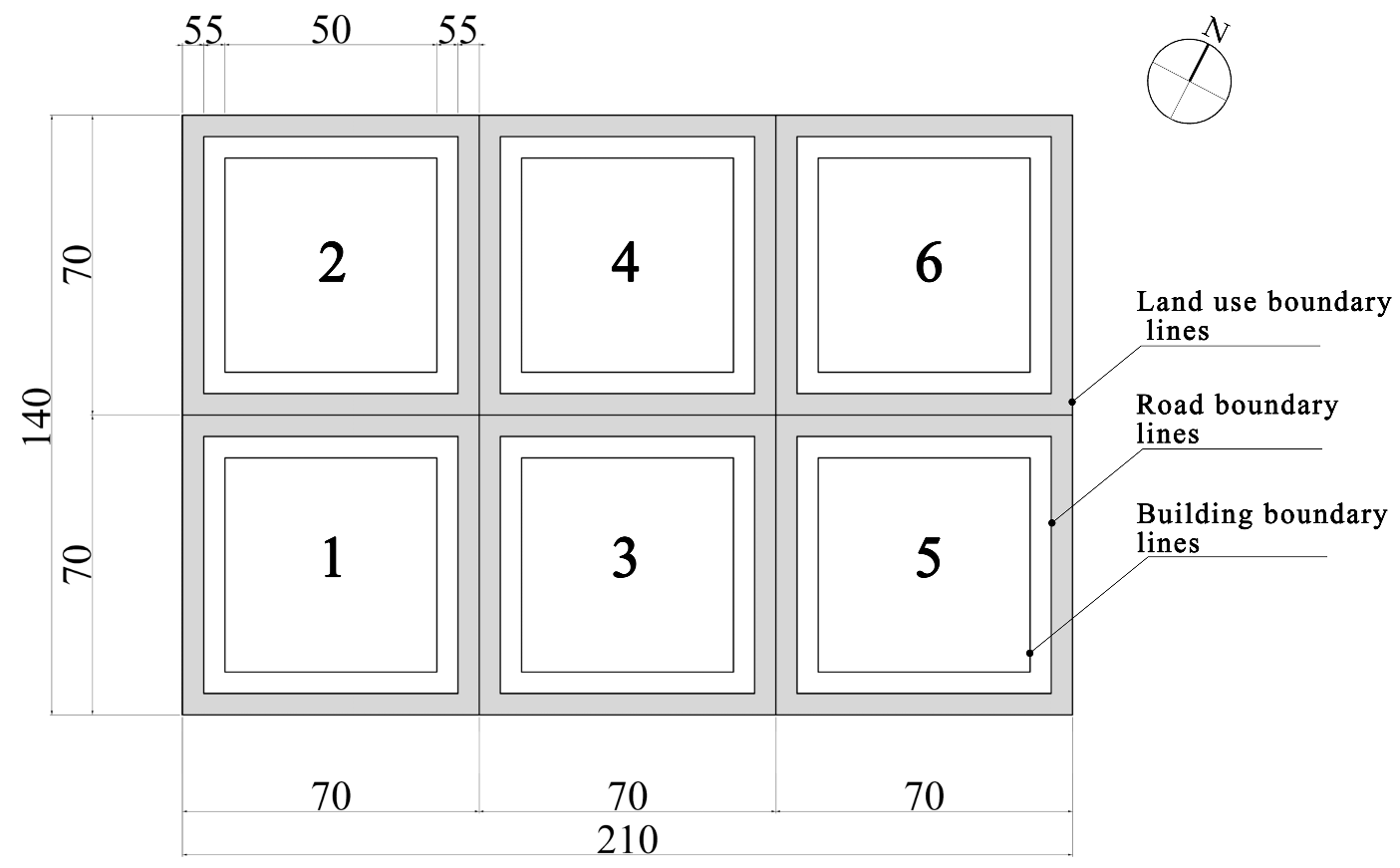
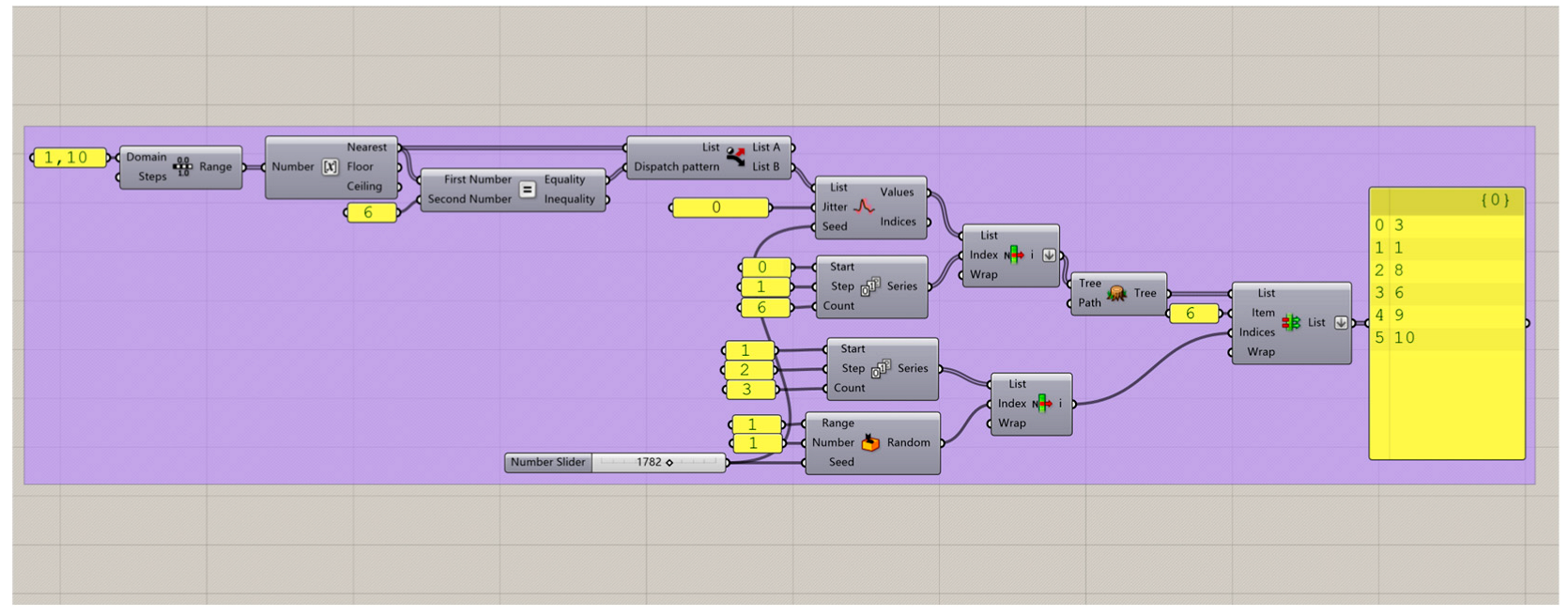

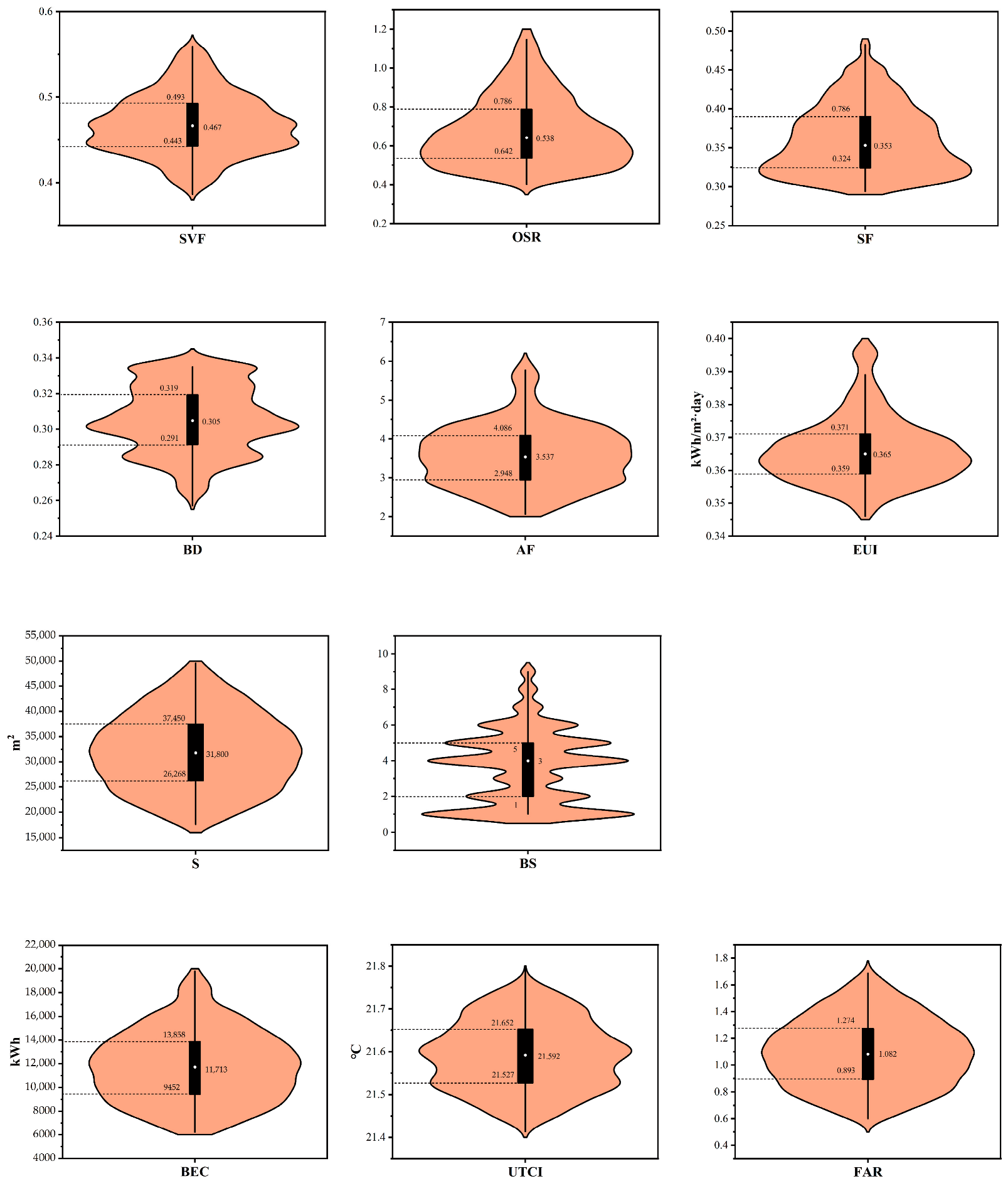







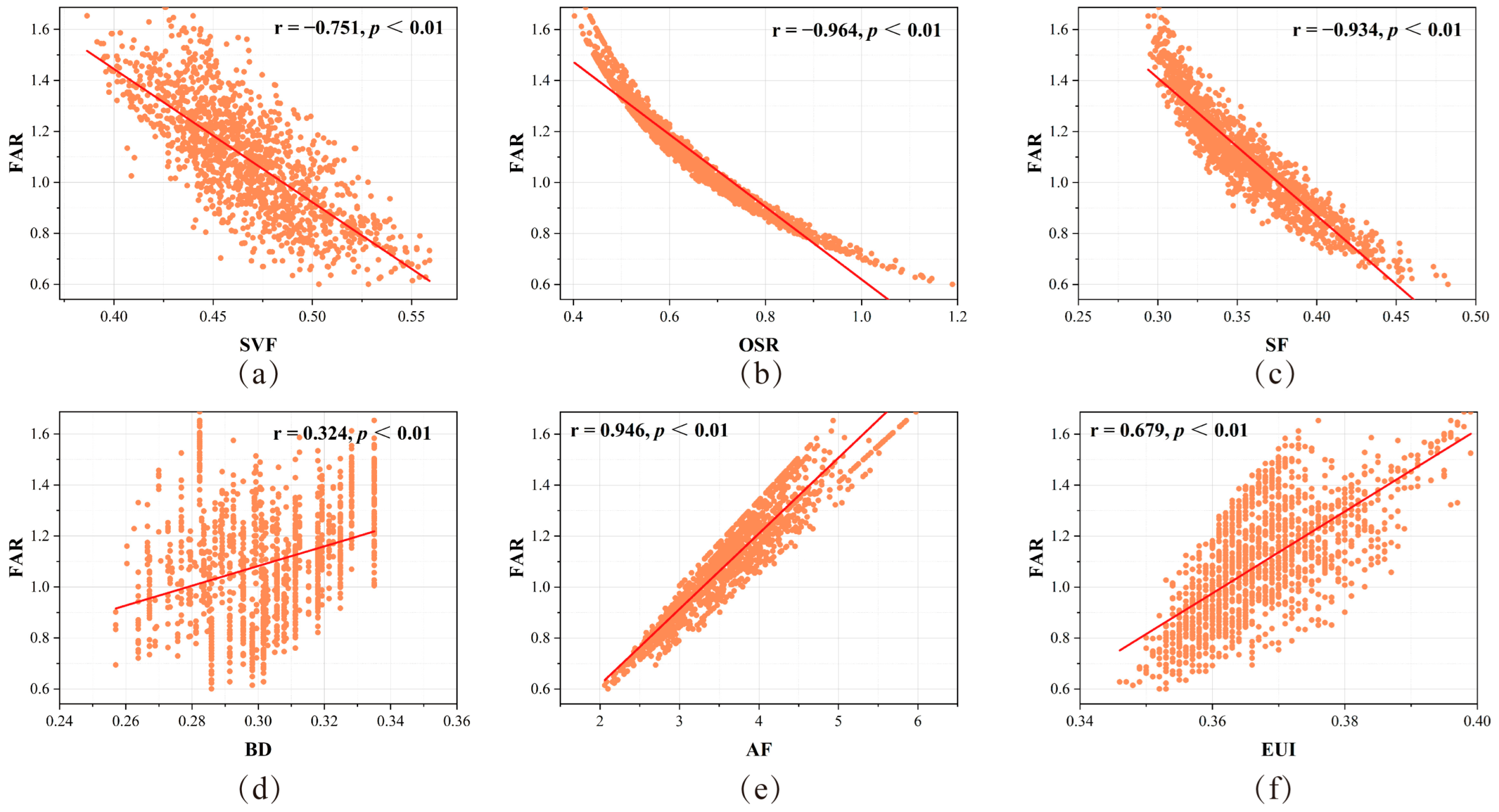
| Code | Extract Buildings | Building Model | Ground Floor Plan | Building Type | Number of Layers | Building Area (m2) |
|---|---|---|---|---|---|---|
| E–1 |  |  |  | Enclosed | 1–3 | 2050 |
| E–2 |  |  | 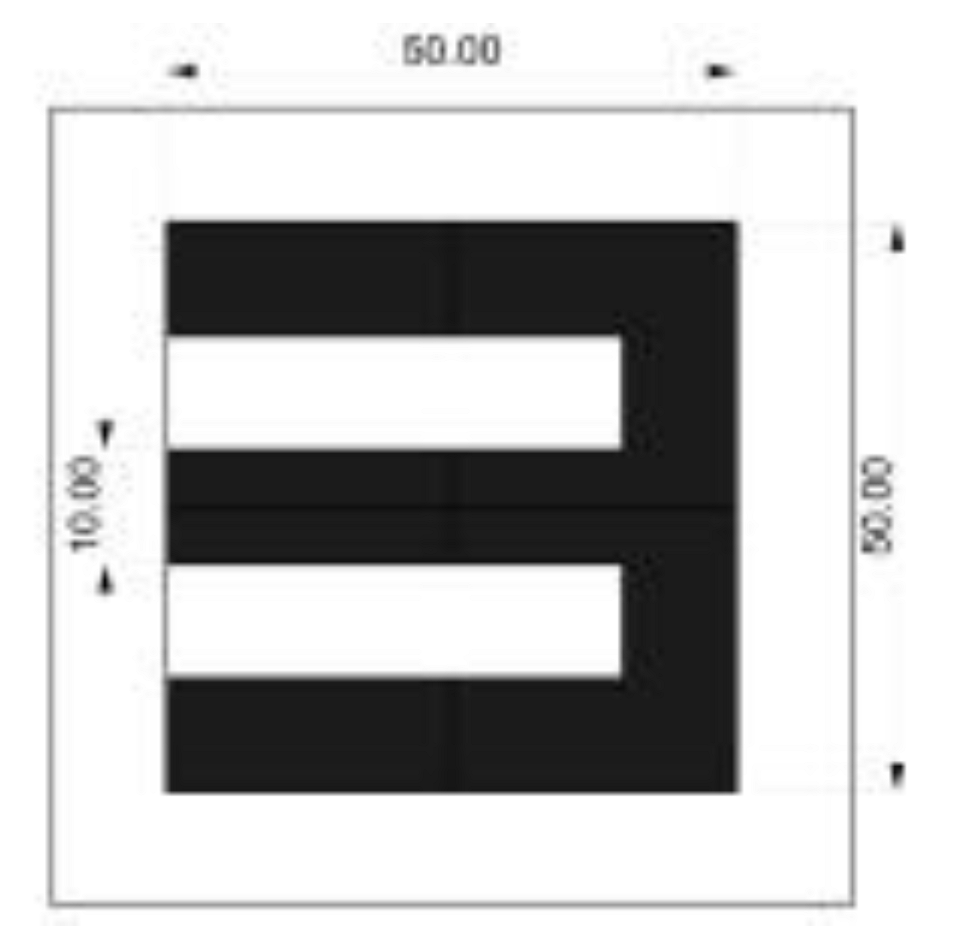 | Enclosed | 1–3 | 1700 |
| E–3 |  |  |  | Enclosed | 1–3 | 1000 |
| S–1 | 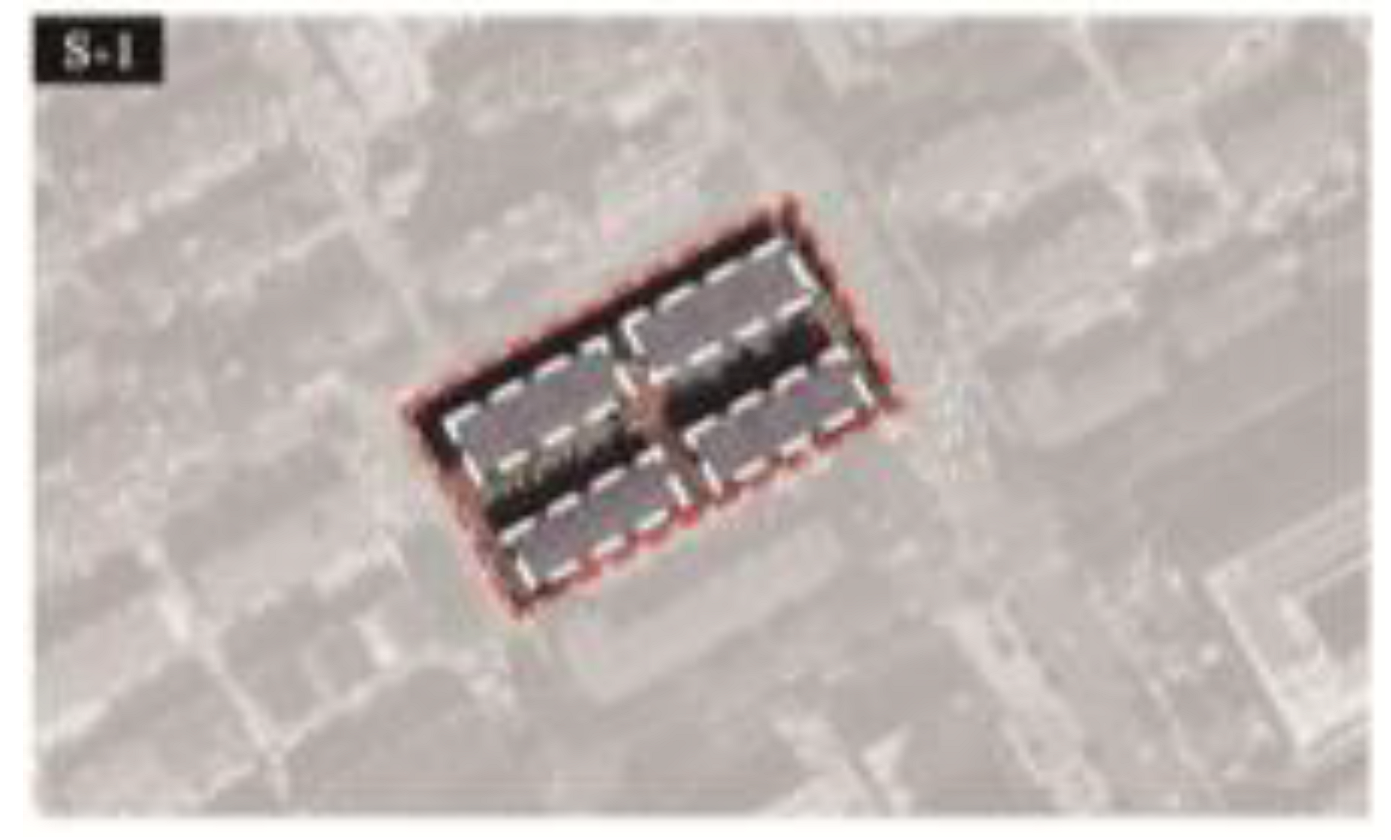 | 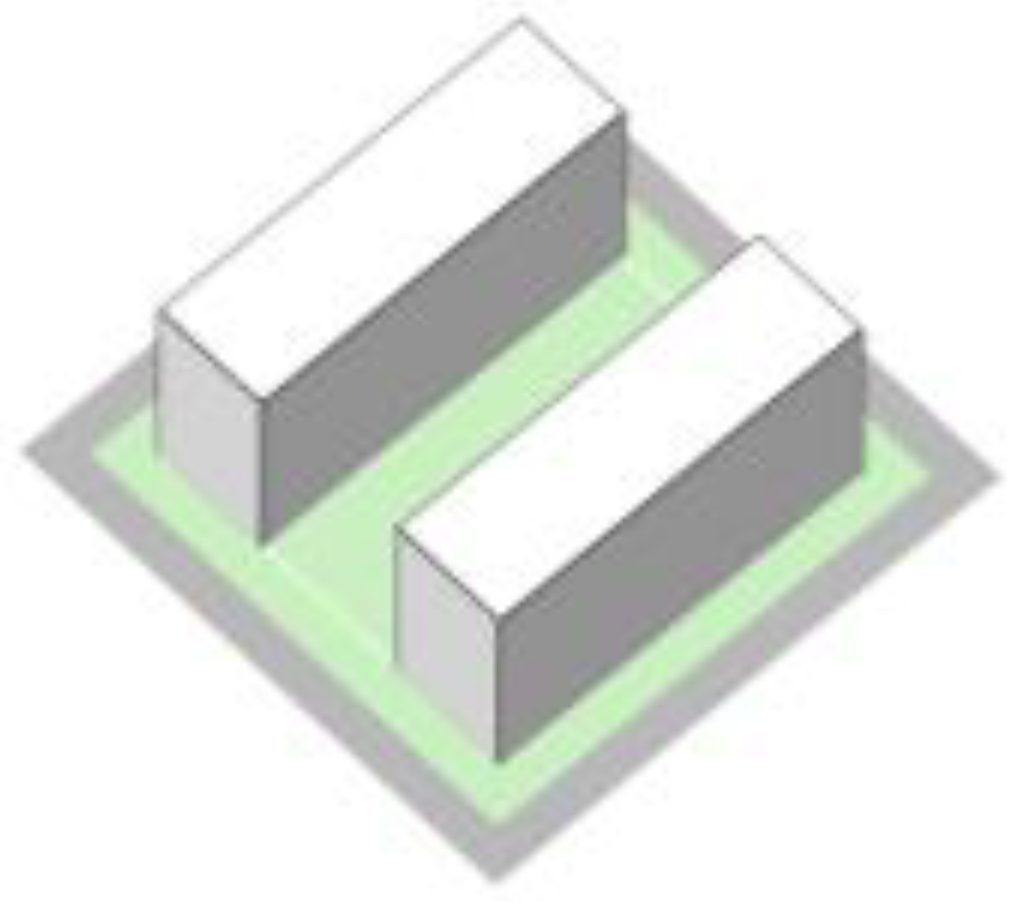 | 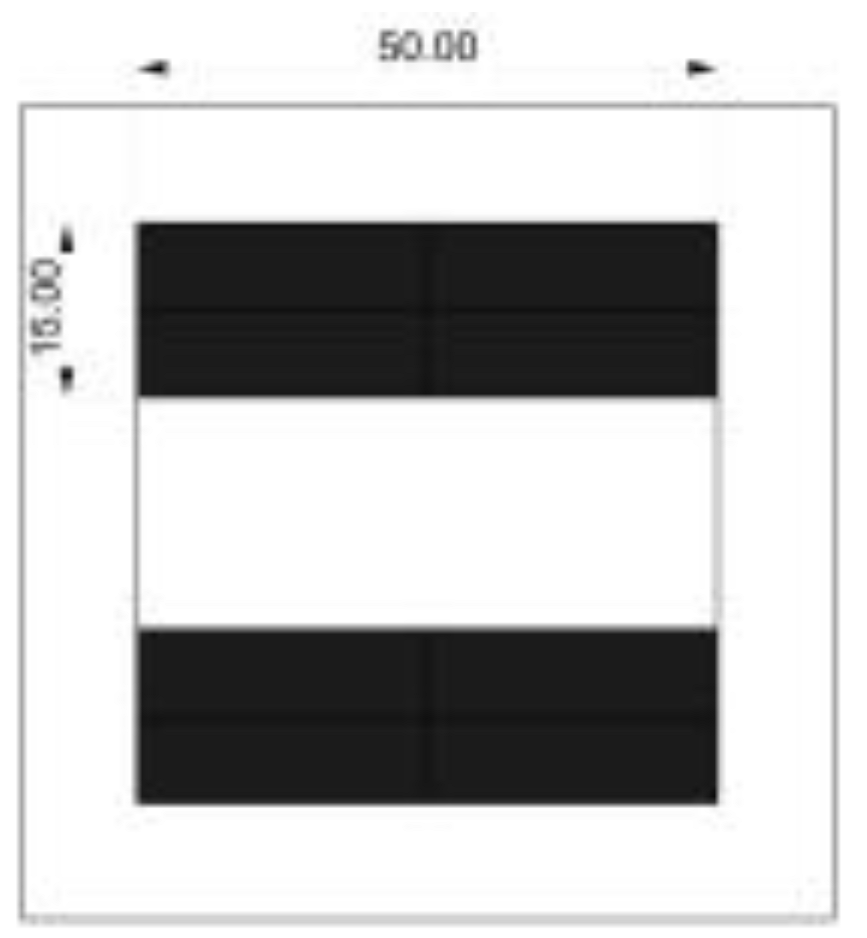 | Slab | 4–9 | 1500 |
| S–2 | 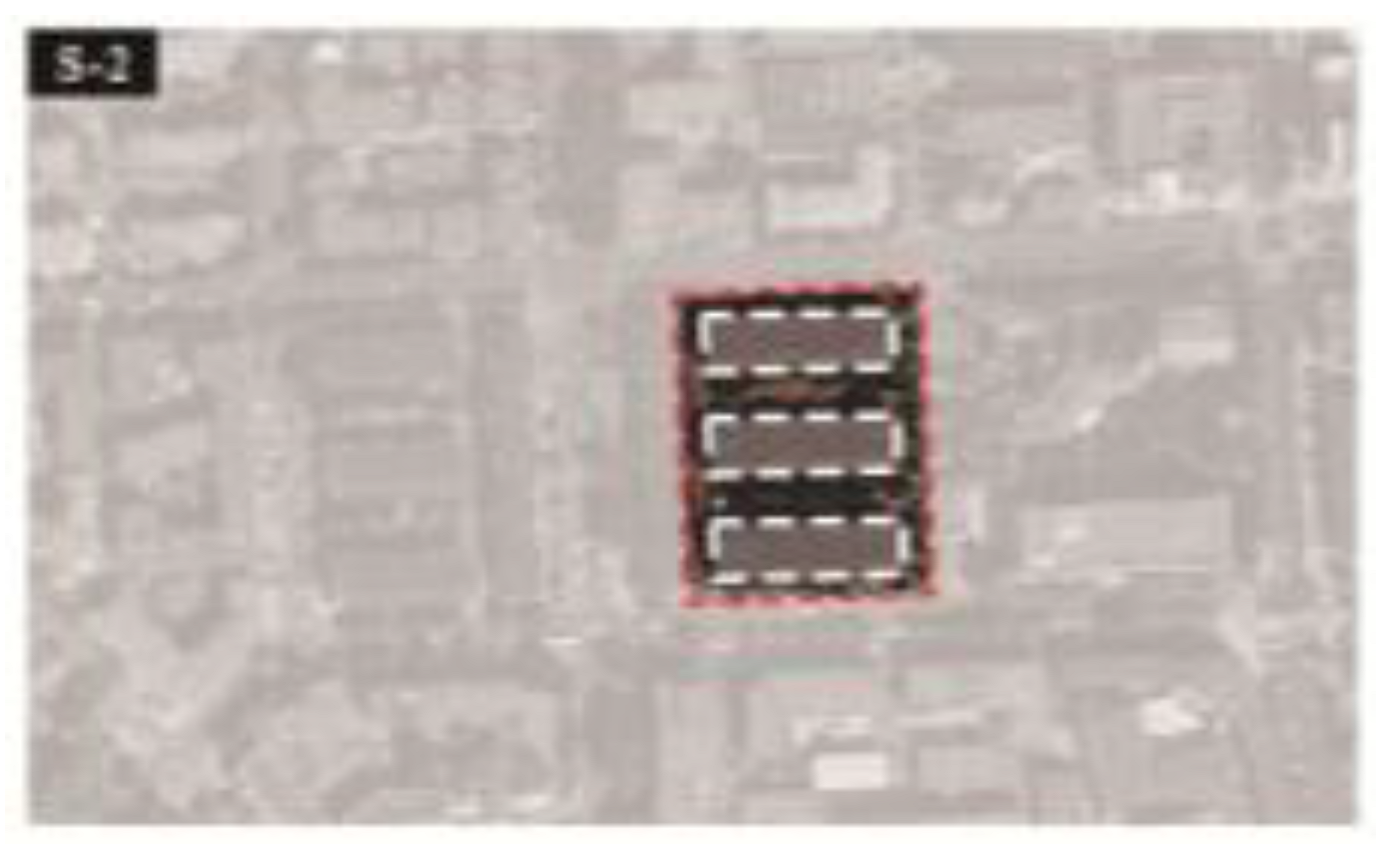 |  |  | Slab | 4–6 | 1500 |
| S–3 | 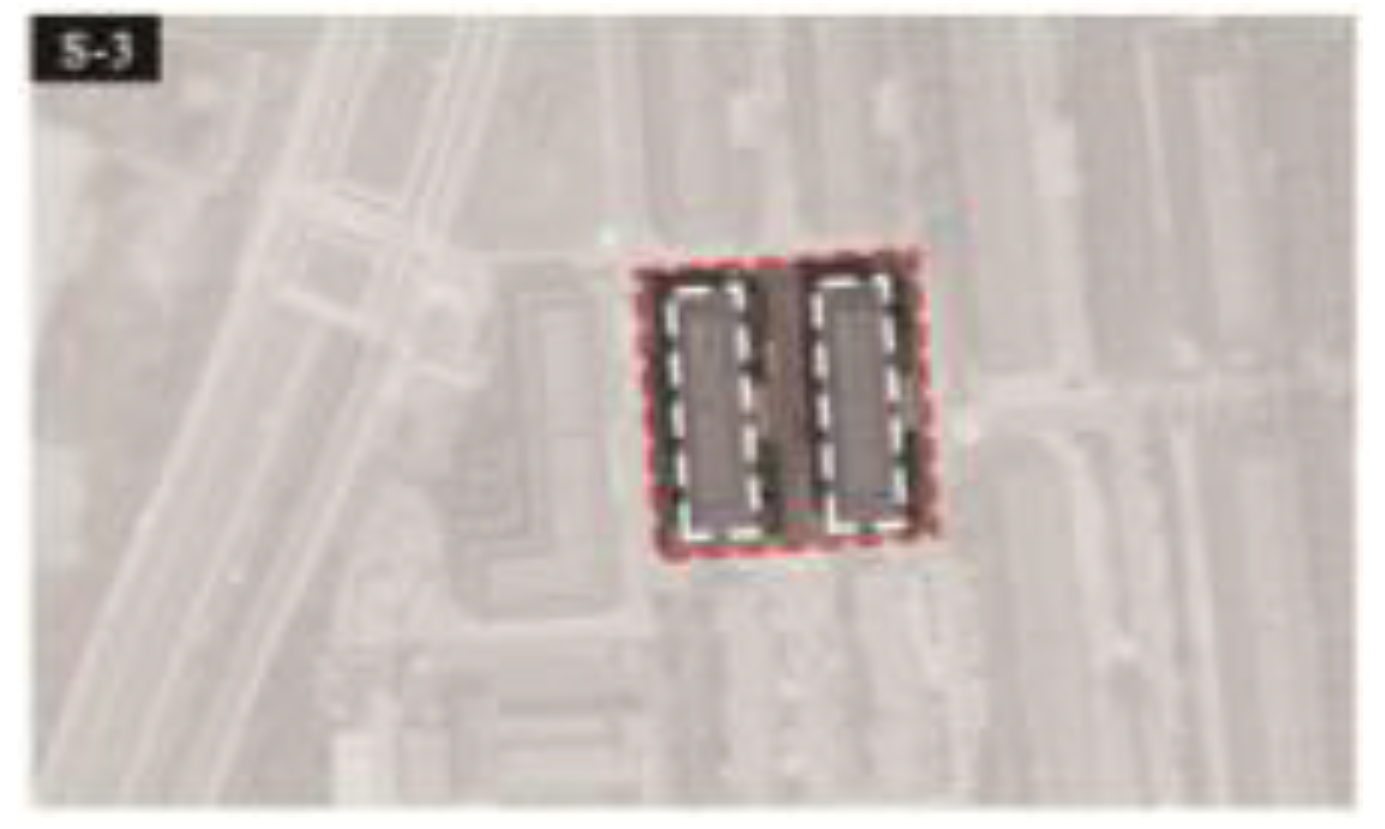 | 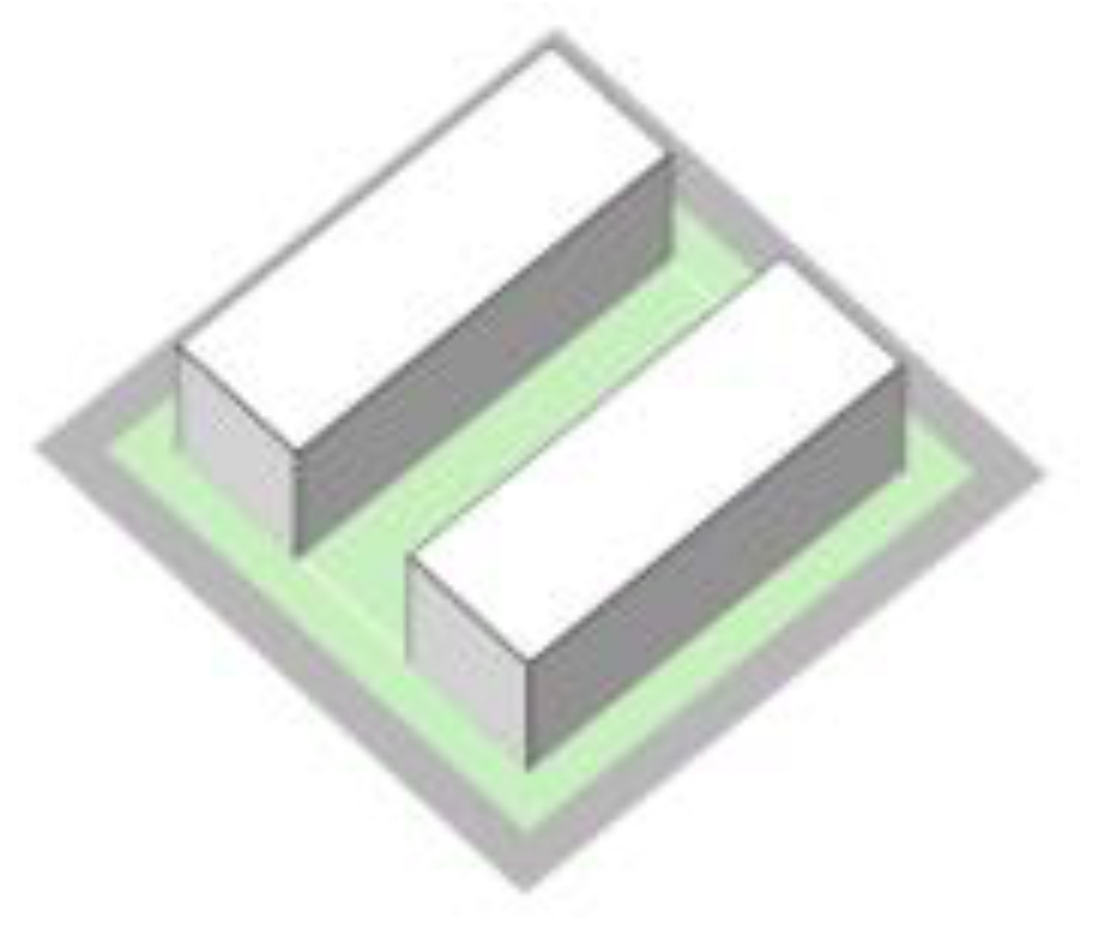 | 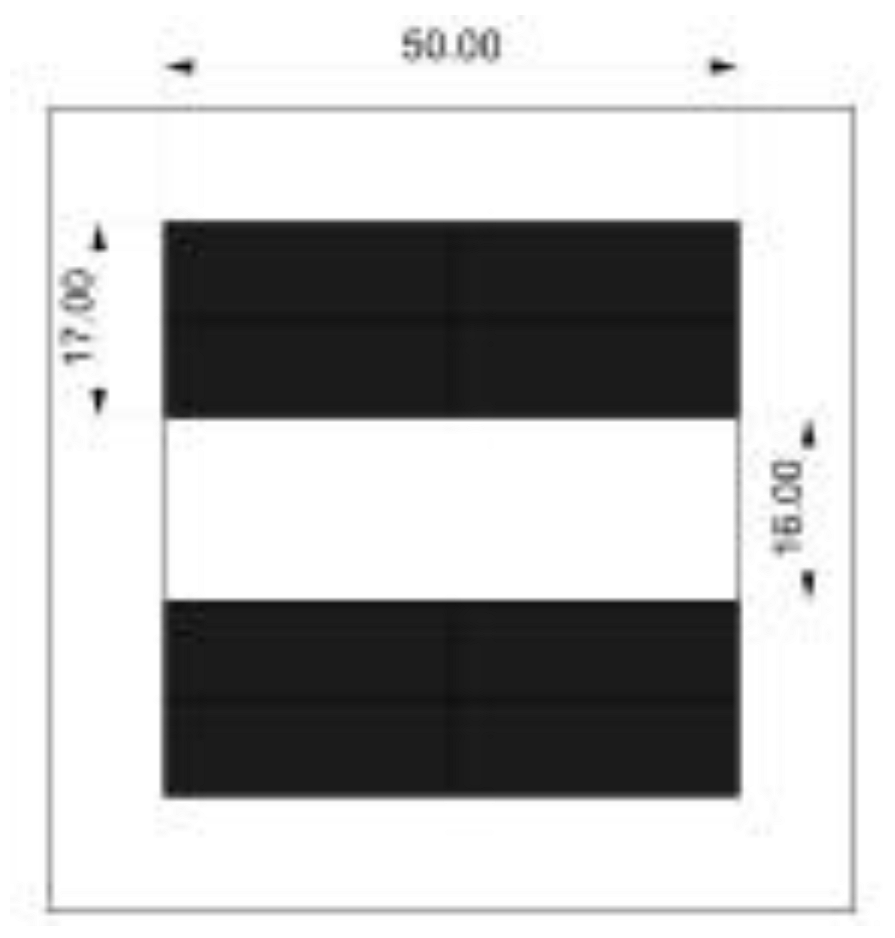 | Slab | 4–6 | 1700 |
| S–4 |  |  |  | Slab | 4–6 | 1400 |
| H–1 |  | 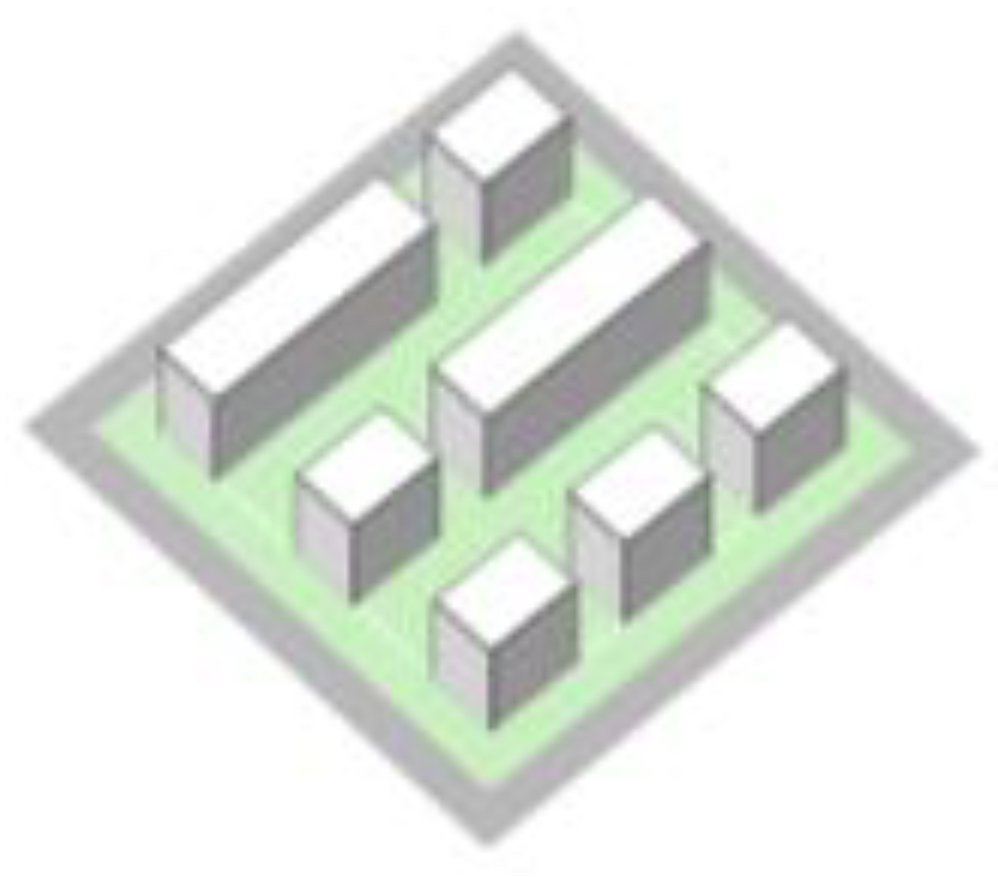 |  | Slab + point | 4–6 | 1037 |
| P–1 |  |  |  | Point | 4–6 | 1200 |
| P–2 |  |  |  | Point | 1–3 | 918 |
| Indicator Name | Calculation Formula | Illustration |
|---|---|---|
| FAR | 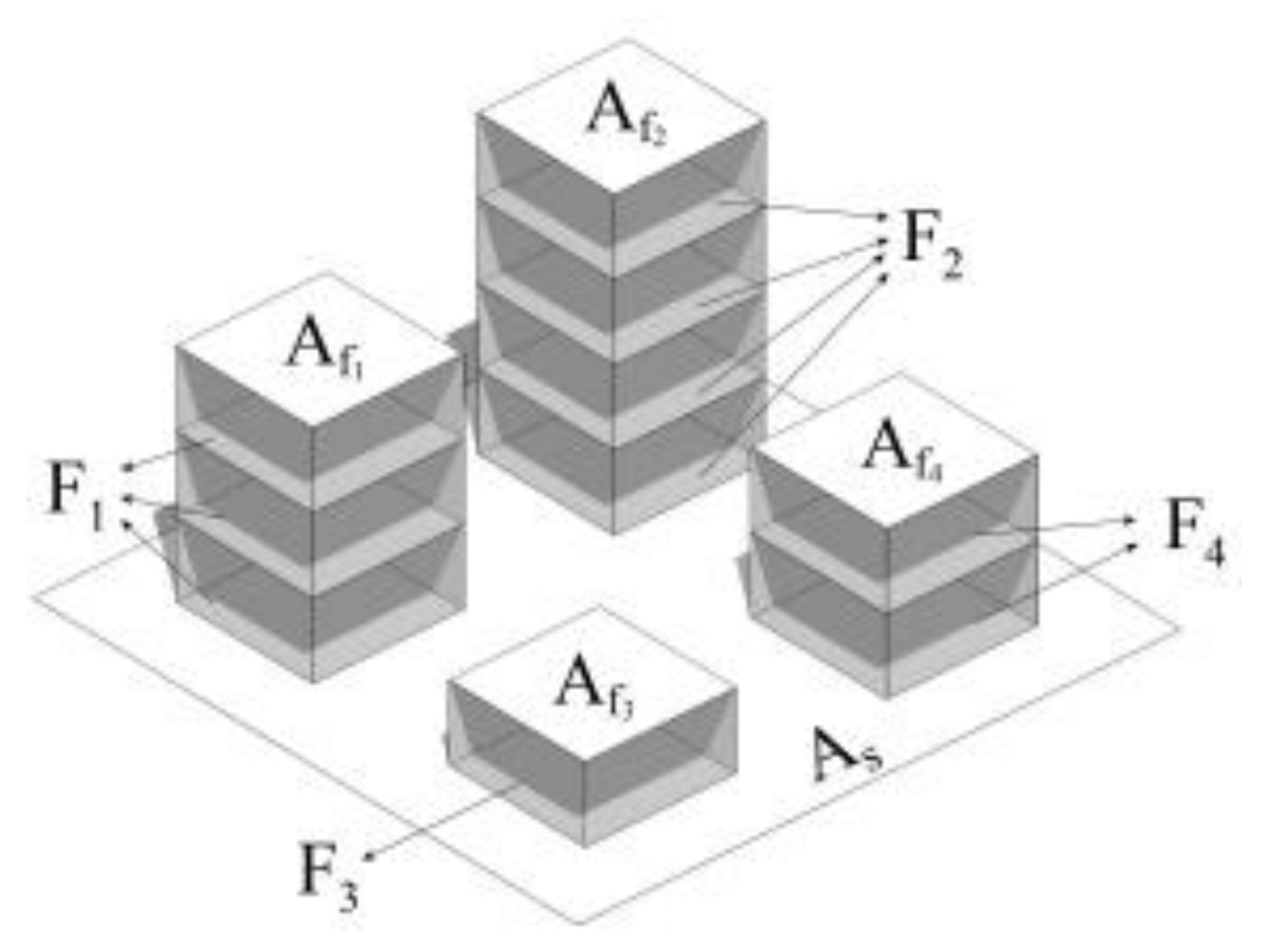 | |
| OSR |  | |
| BD |  | |
| AF |  | |
| SF | 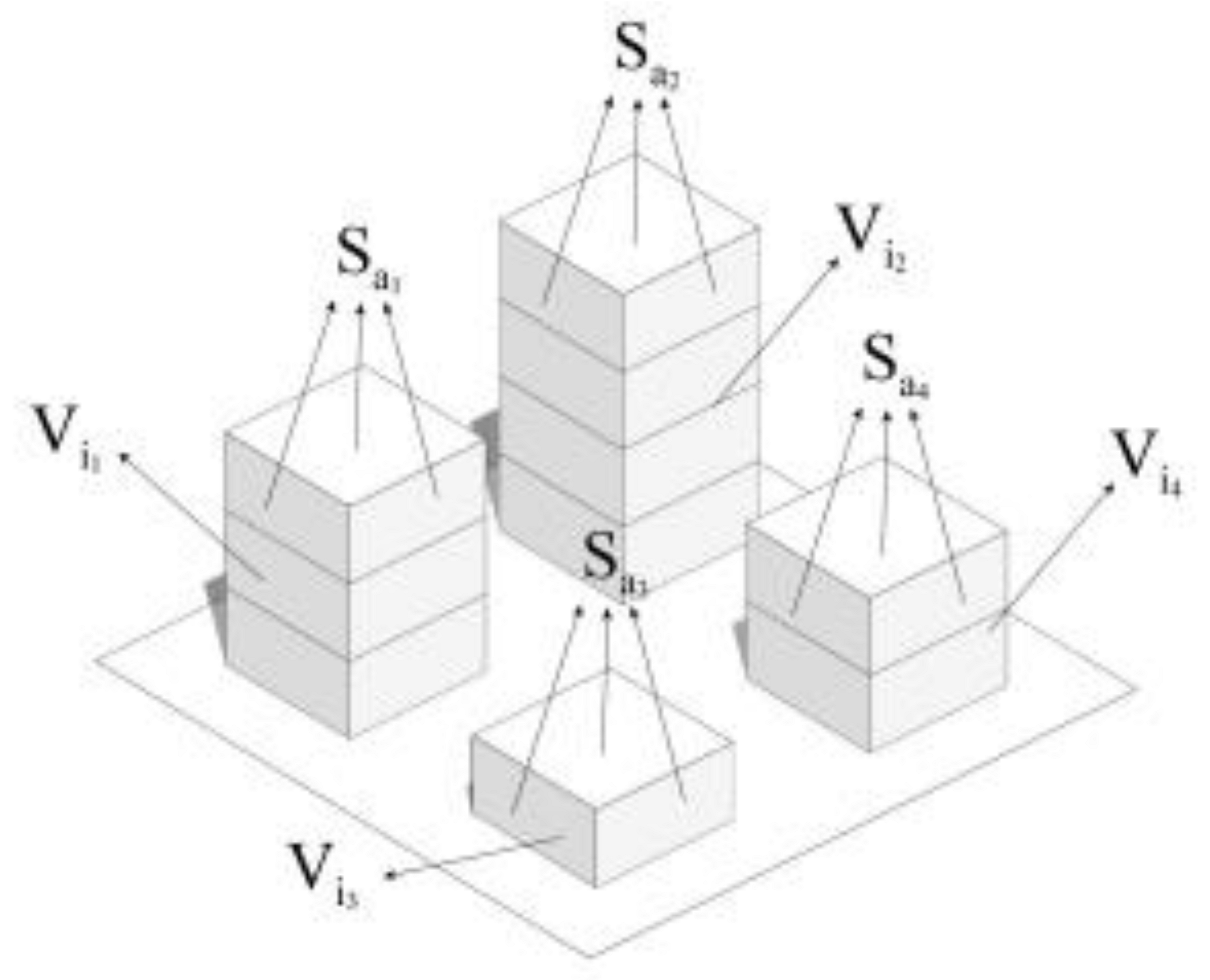 | |
| SVF |  |
| Parameter Type | Parameter Name | Settings |
|---|---|---|
| Time and Date | Start Date—Time | 22 July, 6:00–22:00 |
| Meteorological boundary conditions | - | EPW file modified from UWG’s modeled microclimate results |
| Building | Floor | U value = 0.5 W/m2·K |
| External Wall | U value = 0.8 W/m2·K | |
| Window | U value = 2.2 W/m2·K (SHGC = 0.35) | |
| Roof | U value = 0.8 W/m2·K | |
| Window-to-wall ratio | North/East/West Facades | 0.4 |
| South Facade | 0.6 | |
| Internal Thermal Gain | Lighting | Power Density: 10.0 W/m2 |
| Electrical Equipment | Power Density: 13 W/m2 | |
| HVAC System | Operating Hours: 8:00–21:00 | |
| people | Floor Area per Person: 8 m2/person | |
| Fresh Air Volume per Person: 30 m3/(h·person) | ||
| HVAC System | Cooling Setpoint Temperature | 26 °C |
| Heating Setpoint Temperature | 18 °C |
| Algorithmic Parameter | Parameter Effects | Parameter Settings |
|---|---|---|
| Crossover Probability | Controls the probability that two parent individuals will exchange genes (parameters). The higher the value, the more rapid the emergence of new populations, generally taking the value 0.1–0.99. | 0.9 |
| Mutation Probability | The probability that an individual undergoes random variation. High probability increases diversity but may deviate from the optimal solution; low probability tends to fall into local optimality. | 0.1 |
| Crossover Distribution Index | Smaller values mean that the crossover process children are farther away from the parent, introducing more variation. Larger values mean that the crossover process children are close to the parent, preserving a greater proportion of the parent’s traits. | 20 |
| Mutation Distribution Index | A smaller value means that the mutation process offspring are far away from the parent, introducing more variation. Larger values mean that the offspring of the mutation process are close to the parent, retaining more of the parent’s characteristics. | 20 |
| Random Seed | The value dictates the manner in which the algorithm undergoes initialization. | 1 |
| Population Size | Total number of individuals per generation involved in the evolutionary algorithm. | 40 |
| Max Generations | Determines the longest number of generations for which the algorithm will run. | 50 |
| Design Variable | Variable Name | Unit | Value Range | Increment Step |
|---|---|---|---|---|
| Number of Floors of Building E–1 | X1 | - | [1, 3] | 1 |
| Number of Floors of Building E–2 | X2 | - | [1, 3] | 1 |
| Number of Floors of Building E–3 | X3 | - | [1, 3] | 1 |
| Number of Floors of Building S–1 | X4 | - | [4, 9] | 1 |
| Number of Floors of Building S–2 | X5 | - | [4, 6] | 1 |
| Number of Floors of Building S–3 | X6 | - | [4, 6] | 1 |
| Number of Floors of Building S–4 | X7 | - | [4, 6] | 1 |
| Number of Floors of Building H–1 | X8 | - | [4, 6] | 1 |
| Number of Floors of Building P–1 | X9 | - | [4, 6] | 1 |
| Number of Floors of Building P–2 | X10 | - | [1, 3] | 1 |
| Angle of Building E–1 | X11 | ° | [0, 360] | 90 |
| Angle 1 of Building E–3 | X12 | ° | [0, 360] | 90 |
| Angle 2 of Building E–3 | X13 | ° | [0, 360] | 90 |
| Angle 3 of Building E–3 | X14 | ° | [0, 360] | 90 |
| Angle 4 of Building E–3 | X15 | ° | [0, 360] | 90 |
| Building Type | Plot 1 | Plot 2 | Plot 3 | Plot 4 | Plot 5 | Plot 6 |
|---|---|---|---|---|---|---|
| Enclosed (E–1, E–2, E–3) | 0.453 | 0.316 | 0.522 | 0.113 | 0.522 | 0.506 |
| Slab (S–1, S–2, S–3, S–4) | 0.539 | 0.664 | 0.328 | 0.814 | 0.223 | 0.304 |
| Hybrid (H–1) | 0.004 | 0.004 | 0.040 | 0.053 | 0.020 | 0.008 |
| Point (P–1, P–2) | 0.004 | 0.016 | 0.110 | 0.020 | 0.235 | 0.182 |
Disclaimer/Publisher’s Note: The statements, opinions and data contained in all publications are solely those of the individual author(s) and contributor(s) and not of MDPI and/or the editor(s). MDPI and/or the editor(s) disclaim responsibility for any injury to people or property resulting from any ideas, methods, instructions or products referred to in the content. |
© 2025 by the authors. Licensee MDPI, Basel, Switzerland. This article is an open access article distributed under the terms and conditions of the Creative Commons Attribution (CC BY) license (https://creativecommons.org/licenses/by/4.0/).
Share and Cite
Zhang, H.; You, L.; Yuan, H.; Guo, F. Morphological Optimization of Low-Density Commercial Streets: A Multi-Objective Study Based on Genetic Algorithm. Sustainability 2025, 17, 7541. https://doi.org/10.3390/su17167541
Zhang H, You L, Yuan H, Guo F. Morphological Optimization of Low-Density Commercial Streets: A Multi-Objective Study Based on Genetic Algorithm. Sustainability. 2025; 17(16):7541. https://doi.org/10.3390/su17167541
Chicago/Turabian StyleZhang, Hongchi, Liangshan You, Hong Yuan, and Fei Guo. 2025. "Morphological Optimization of Low-Density Commercial Streets: A Multi-Objective Study Based on Genetic Algorithm" Sustainability 17, no. 16: 7541. https://doi.org/10.3390/su17167541
APA StyleZhang, H., You, L., Yuan, H., & Guo, F. (2025). Morphological Optimization of Low-Density Commercial Streets: A Multi-Objective Study Based on Genetic Algorithm. Sustainability, 17(16), 7541. https://doi.org/10.3390/su17167541










